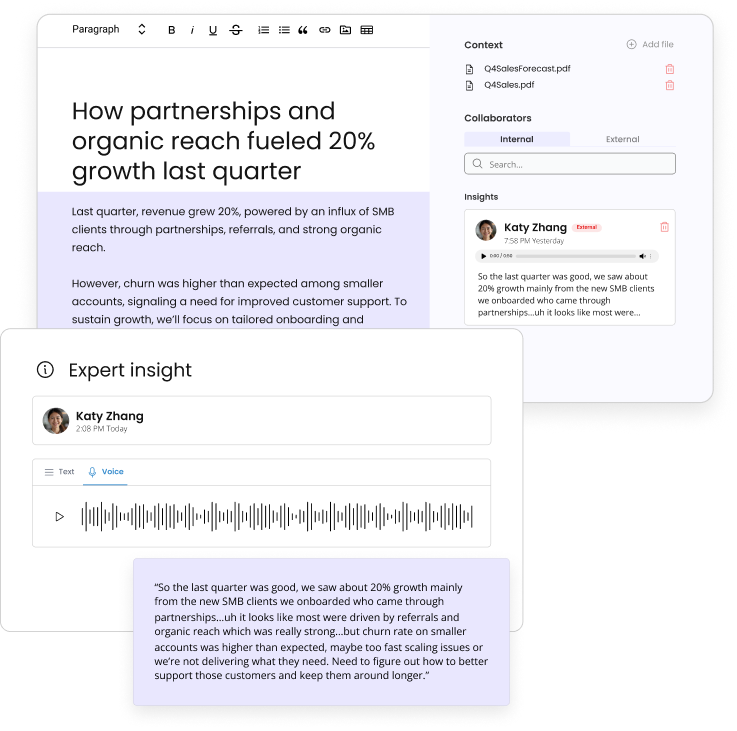Table of Contents

Authority scales when expertise comes first
Wordbrew helps teams collect expert insight before AI ever writes a word.
Built for expert-led, review-safe content
- Home
- »
- Content Marketing
- »
- 13 writing best practices for better content
-
Muhammad Umer
- 10 minutes read time
13 writing best practices for better content
- Home
- »
- Content Marketing
- »
- 13 writing best practices for better content
13 writing best practices for better content
Table of Contents

Quality content is at the heart of every marketing effort. It helps to convey the intended message and prompt the desired actions from readers.
But how do you create content that resonates with your audience is the real question.
It’s simple: Follow the best practices in writing.
We’ve covered 13 of our writing best practices in this blog to get you started. But before we dive into them, let’s talk about why following best practices in writing is important in the first place.
Why should you follow writing best practices?
Following best practices in writing is essential as it ensures clarity, engagement, and professionalism in your writing. The result? You get to deliver impactful and memorable content, which is critical in any successful strategy.
Now that you know why these practices are important, let’s dive into them.
1. Make your content clear, not clever
Complex phrases or strong vocabulary may sound tempting, but they seldom add value to your piece. Give clarity the precedence and ensure that your message is easily comprehensible for the masses.
You can start by avoiding unnecessary words. Make every point with the precision of a surgeon.
For example, use “help” instead of “provide assistance” or “boost” instead of “increase the likelihood.” It’s fewer words, easier to comprehend, and avoids ambiguity, making it easier for readers to understand exactly what you’re trying to convey.
For even crisper text, use terms that everyone understands—not just industry insiders. For example, instead of saying, “Leverage our robust CRM solutions,” say, “Use our customer-friendly tools,” to make it easier for a larger audience to understand.
2. Make your content actionable
Actionable content equips your audience with practical steps to apply the information you provide them.
Making content actionable empowers readers to not only grasp the concepts but also to implement them, which enhances engagement and reinforces the value of your content. Wix knows what we’re talking about:

Here’s how you can create actionable content that readers can use:
Add calls to action (CTAs)
Clear and compelling CTAs are the signposts that tell readers what to do next. It’s the difference between finding a button labeled “Click here” versus one that says, “Get your free eBook now!” The latter not only tells the reader what they’re getting but also prompts an immediate response.
Here’s another example: If the goal is to increase newsletter sign-ups, an effective CTA would be: “Join our community of professionals. Enter your email to receive exclusive insights.”
Recommended read: Here’s How to Start A Newsletter According to 7 B2B Experts
Offer step-by-step guidance
Don’t just tell your readers what to do—tell them how to do it! Breaking down complex ideas into smaller, actionable steps can turn a daunting task into a simple process for them.
Each step should act as a milestone, allowing readers to digest and apply information before moving on to the next.
For instance, don’t say, “Grow your audience.” Break it down into steps like “Leverage social media platforms,” followed by “Engage with your readers through comments,” and then “Use email marketing to keep followers updated,” with descriptions for each part.
Provide resources
Providing resources or tools alongside information makes it more accessible. Resources can be checklists, templates, links to other articles, or even third-party tools.
These are the “tools” you give your readers to turn insight into action. For example, if the content is about “writing best practices,” a link to a grammar-checking tool could be invaluable.
3. Address potential objections
When writing blog posts, it is important to anticipate and address readers’ potential concerns. It’s similar to when a friend tells you about a new phone that’s all the rage, but you’re thinking, “Yeah, but what if it’s too expensive?”
You need to address those “yeah, but…” moments—those are objections.
It’s important to talk about these objections because it shows that you’re not just sugarcoating things—you understand your readers’ worries.
You can address readers’ potential objections by:
Thinking like a reader
Imagine you’re the reader and ask all the tough questions. For example, if you’re writing about a snack that’s tasty and healthy, think about the reader asking, “Yeah, but is it affordable?”
Being honest and reassuring
If a tool’s subscription costs a bit more, say so, but explain why it’s worth the extra pennies. Maybe it has certain features that no other tool on the market offers.
Doing this tells readers you get what’s buzzing in their heads. Plus, it helps build trust, which means they’re likely to come back to read your next piece as well.
4. Avoid technical jargon (unless necessary)
Think of technical jargon as those industry-specific words that people use when they’re experts in a certain area.
Imagine a soccer coach talking about a “4-4-2 formation.” If you love soccer, you know they’re talking about a strategy with four defenders, four midfielders, and two forwards. But someone who doesn’t watch the sport might be confused. That’s what jargon is like—a secret code for people in the know.
Now, why should we avoid packing our writing with too much of this secret code? Because not everyone understands it! It’s like trying to read a menu in a language you don’t speak. You won’t know what to order!
You should explain things in a way anyone can understand—a must-have writing skill. For that, you can:
- Use everyday words instead of technical ones, such as saying “start” instead of “initiate.”
- Explain a fancy word if you use it. We did this above with the “4-4-2 formation” example.
Let us give you another example: Instead of puzzling people by saying “photosynthesis,” you could say, “It’s how a plant eats and breathes using sunlight.” See?
It’s all about keeping it clear and simple.
Note: If you’re writing blog posts for experts, like a blog on How to create a B2B content marketing funnel that drives revenue for mid-to-high-level executives, then using industry-specific jargon will make your work more engaging.
5. Offer comparative analysis
Offering a comparative analysis is like providing a clear, detailed map that highlights the different paths readers could take. For instance, you can point out the pros and cons of each product you’re comparing, helping readers understand what each one brings to the table.
Comparative analysis is key because it’s all about clarity and helping readers decide. It gives them a full picture to identify the product that’s best for them.
Three main factors go into offering comparative analysis:
Transparency
Be clear and honest about the features of your software, even when it might not be the top option. It’s like acknowledging that one car has better fuel economy while another might have a better safety rating.
Options
Educate your readers about their choices, just like explaining the difference between organic and regular produce.
Accuracy
Support readers in making a well-informed decision by laying out all the information neatly and precisely.
So, how do these translate into technical writing?
Let’s assume you’re writing a B2B SaaS blog comparing tools for project management. You might note that one tool excels in user-friendly design while another offers more advanced features but has a steeper learning curve.

Source: HubSpot
This way, your readers can pick the tool that aligns best with their team’s needs and expertise.
6. Highlight long-term value
Show customers that their purchase won’t just be good today but will keep being great years from now.
Why do this? Well, it’s like opting for a SaaS tool that’s good for your team of 20 and has the capacity to scale as your team grows. Highlighting long-term value will help customers see they’re making a smart choice for the future—not just a quick fix.
You can do this by spelling out the money-saving magic. Talk about how getting a good scalable tool might cost more now, but it means that they won’t need a new one every year.
Highlight that it’s difficult to onboard a new tool when your team of 20 has soared into multiple departments. Also, write about how your product or service will keep improving for the reader over time, making down-the-road scalability a breeze for your audience.
7. Incorporate expert insights
Embedding expert insights (quotes or advice from experts) in your content, articles, or posts is like a stamp of approval that makes your information more trustworthy. They:
- Add more credibility to prove your point and make your argument stronger.
- Offer a deeper dive into the topic, helping readers understand it better.
- Increase engagement because expert opinions spark readers’ interest and get them thinking.
You can source expert opinions through a one-on-one interview by reaching out to experts on platforms like LinkedIn or sourcing quotes from websites like Help a B2B Writer or HARO.
When you’re including them in your blog, always:
- Choose respected voices in the industry, like how a good cook might pick a well-known brand of ingredients. Renowned experts will have a greater impact on your audience.
- Explain the expert’s viewpoints in a way that’s easy to understand without complicated words. They often use complex terms and jargon, which may be difficult for your target audience to understand.
- Use real-life examples that clearly explain the expert’s perspective.
In a nutshell, don’t just add quotes to your blog. Dedicate a few lines to explain their point and how it aligns with your statement.
For instance, if you’re writing content about time-tracking tools, you might include a quote from a tech CEO explaining why a particular tool is a game-changer for remote teams. Or you might reference a survey by a big tech research firm to show how one tool is leading in customer satisfaction. This makes your content richer.
8. Integrate data visualizations
Integrating data visualizations means using pictures like charts and infographics to show numbers and stats in a way that’s easy to understand.
For example, check out how McKinsey added this visual to help readers understand the gist of their blog on How US customers’ attitudes to fintech are shifting during the pandemic.

Source: McKinsey
It’s important to add these visuals in your write-ups because they make it easy for readers to get the point without getting lost in an ocean of numbers. It’s like using the interactive map on your phone to navigate instead of reading a long list of directions.
In fact, a Venngage study identified that over 50% of marketers used visuals in their content.
Data visualizations also grab readers’ attention better than just words, making them stick around and read more.
To jazz up your blogs with data visuals, you should:
- Pick the right kind of picture for the data—like choosing a bar graph to show which brand of sneakers is most popular.
- Make sure these visuals are clear and colorful to catch the eye.
- Use professional tools like Canva or Adobe Photoshop to create these images, ensuring they look sharp and neat.
In short, don’t forget the data visuals!
9. Deep-dive product knowledge
Deep-dive product knowledge means you understand every detail about your topic, from what it’s made of to exactly how it works.
Sharing detailed product knowledge builds trust because you, as an expert, share a unique point of view on the product in your write-up. People will read this piece to identify concrete solutions to their pain points, which they won’t find anywhere else.
You can showcase your command on the topic by:
Simplifying complex details
Break down tricky product specs into simple explanations. Imagine explaining a video game’s levels in a way that someone who’s never played it would understand.
Explaining the intricacies
Provide first-hand information about the product with screenshots instead of just listing its features. Explain how everything works and how readers can make the most out of each feature.
Staying Updated
Keep your content fresh with the latest updates. You can publish a new blog on the same topic (if there’s a complete overhaul) or edit the original one (in the case of minor updates) to add whatever’s new.
10. Always start with an outline
Creating a content outline is like making a map for your writing journey. This initial step helps you set up your thoughts and ideas so that everything in your article makes sense and connects well.
This method will make your writing process faster since you already know where you’re heading. With an outline, you’re also less likely to hit a dead end. It’s like having all the ingredients ready before you start cooking—you can finish your dish faster, and it’s more likely to taste good.
To make a great outline, you need to:
- Pick main points: Select the most interesting ideas for your writing.
- Arrange them wisely in a way that makes sense.
- Link them together so each point leads naturally to the next.
Think of a contractor building a house. They start with a blueprint so they know where to put everything, from the doors to the windows. An outline does the same for a writer, placing every idea where it fits best.
11. Use examples where possible
Using examples in writing makes everything clearer and more interesting. When you read something with good examples, it’s like seeing a mini-movie in your head that shows you exactly what the writer means.
Here’s why examples are super helpful:
Examples create analogies for tricky ideas
For instance, if you’re explaining how photosynthesis works, an example would be showing how leaves turn sunlight into food, just like a solar panel turns sunlight into energy.
Here’s another example of how Timothy Choi used analogy to explain APIs in one of his blogs on Medium.

Source: Medium
They’re a bridge to the real world
Good examples connect complicated stuff to everyday things. Let’s say you’re writing content about teamwork. You could use examples like a soccer team passing the ball to score a goal, something most people would know about.
You can slip examples into your writing through:
Storytelling
Share a short story that paints a picture of your point, such as a sports commentator describing a key play in a game.
Comparing
Use comparisons to familiar things. For example, “a computer’s memory is like a huge library where information is stored.” This way, anyone who knows about a library will understand how computer memory works.
Detailing real-life situations
Mention actual events or facts, like a scientist’s discovery or a historical event, to show how your ideas work outside of a book or article.
Think about a guide showing you how to assemble a toy—without pictures, it can be really hard. But with pictures, you can see each step and understand how to do it yourself. That’s the power of examples in writing!
12. Use writing frameworks
Writing frameworks give you steps to follow to ensure stories and articles are as effective as possible. They help organize thoughts so readers can easily digest the information and stay hooked from start to finish. Some well-known writing frameworks are:
LEMA—Logic, Explicitness, Memorability, and Actionability
This is akin to giving a tour, making sure each step is clear and exciting, and ending with a call to action.
PAS—Problem, Agitation, Solution
The PAS framework starts with highlighting an issue and the problems it causes, followed by a solution to fix that issue.
Frameworks help you create content with a clear path from the first word to the last while keeping your readers glued. Think of them as the blueprint for a construction project. They ensure that the structure is built correctly and safely.
13. End with a strong CTA
A strong call to action (CTA) tells the reader the prize and how to get it. It is a crucial component of any write-up because it gives the reader a map to follow, whether it is to grab a free ebook, sign up for a webinar, or buy a gadget.
Writing a CTA that triggers action can be challenging, which is why you need to:
- Tell your target audience exactly what to do, like “Click here to get your free ebook!”
- Let them know what’s in it for them. For example, “Get exclusive access to proven marketing strategies that elevate your B2B game!”
Putting it all together
Crafting compelling content is an artful blend of anticipating doubts, simplifying jargon, presenting clear choices, and highlighting lasting benefits. Our 13 best practices will let you take up the challenge by advancing your writing skills and helping you create engaging and full-of-value write-ups.
Still having trouble? Let Wordbrew take it from here.
Our subject matter experts brew a unique blend of AI and human content, driving compelling narratives that engage your audience and deliver cost-effective results—try Wordbrew today!
